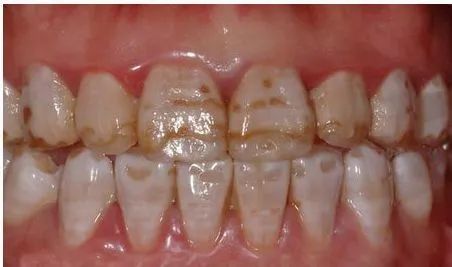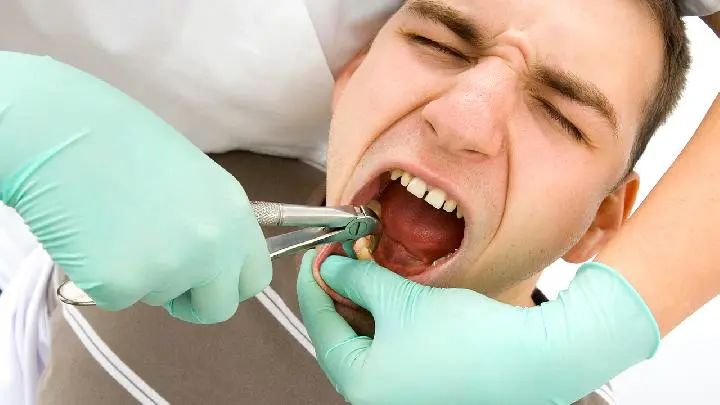 Open wechat
Open wechatSpot enamel (disease), also known as dental fluorosis and macular teeth, is an endemic disease, which is a special type of tooth enamel hypoplasia caused by excessive fluoride intake during the period of tooth development.
Dental fluorosis is a prominent symptom of regional chronic fluorosis, so it is also called dental fluorosis.
The absorption of fluoride in food depends on the solubility of inorganic fluoride in food, and the content of calcium.
If the calcium compound is added, the absorption of fluorine is significantly reduced.

Animal experiments confirmed that: sufficient vitamin A, D and appropriate amount of calcium, phosphorus, can reduce the damage of fluorine to the body.
This shows that high fluoride is not the only cause of fluorosis, because areas with higher fluoride in water are not everyone suffering from the disease.
There are two ways for treat fluorosis 1, grinding, acid erosion coating method Two treatments for dental fluorosis are suitable for dental fluorosis without substantial defects.
The specific steps are described as follows: (1) Clean and treat the affected teeth.
(2) Choose a fine pointed diamond tooth drill, from near to far, but also from far to near, along the cutting edge to the neck.
While inding and dripping water, evenly grinding the dyeing layer under maintaining wet conditions 0.1~0.2mm. Pay attention to the shape of the teeth when grinding, should not deepen in the color plaque area and leave dents.
After grinding, flush it out with running water.
(3) Get wet, dry the teeth, wipe them with 35% phosphoric acid for 3 minutes, rinse the running water, and dry the air gun.
(4) Apply adhesive, blow to a thin layer, and solidify with visible light for 40 seconds.
(5) Wipe away the anaerobic layer with ethanol, and the tooth surface is smooth and shiny.

2, composite resin repair Suitable for dental fluorosis with parenchymal defects.
The specific steps are described as follows: (1) Wear away the lip side coloring or loose enamel, and the thickness is generally 0.3~0.5mm.
(2) Acid erosion teeth: under wet conditions, dip a special small brush in 35%~55% phosphoric acid and evenly wipe the tooth surface for 1 minute.
Acid erosion time should not be too long, otherwise form a layer of insoluble reactant; moreover, too long acid erosion, can seriously damage the normal structure of enamel, and can not increase the retention.
It should be noted that the acid treatment agent should not flow into the gingival groove. After acid erosion, wash repeatedly with distilled water or running water to wash the acid and calcium salt debris. Patients should not gargle during this process.
Finally, use compressed air without oil mist to dry the tooth surface, which is chalky or gray.
(3) Adhesive: use a small brush dipped in the adhesive on the tooth surface after acid erosion, blow gently with an air gun, make it uniform, and not thick, otherwise, volume contraction, large thermal expansion coefficient, low mechanical performance, easy to cause bonding failure.
After 20 seconds of irradiation with visible light, the adhesive can be initially cured.
(4) Repair: according to the patient's age, complexion and adjacent tooth color and other selected materials, color under natural light; take the appropriate composite resin, with fingers, stainless steel sculpture knife shape, push in the required part, not beyond the cutting margin.
The cervical end stops at the gingival margin, can not go deep into the gingival groove and cover on the gum, push the composite resin can not have bubbles.
After the shape is satisfactory, according to the thickness and color type of the material, with visible light irradiation for 40~60 seconds to make the curing.
The distance between the tip of the light guide rod and the material, the better, generally no more than 1mm. According to the shape of each tooth sculpture, there should be an overall concept.
For example, when the crown is too short, the sculpture should make the teeth near, far in less book, the central part is relatively protruding, thus appearing the teeth longer, can increase the beauty.
(5) trimming and polishing: pay attention to the morphology and occlusal relationship of the lip surface.
Eliminate early contact and remove excess material from the gingival margin.
Resresin surface has a layer of sticky anaerobic, the surface must be ground and polished.
Use occlusal paper for the median, forward extension, lateral occlusion, check whether there are early contact points.
If any, use diamond dental grinding, and can appropriately reduce tooth contact to reduce the bite force.
Operation principle: from coarse to fine, under dripping water, grinding speed is about 1000 r/min, and finally with a rubber grinding cup or cloth wheel dipped in very fine abrasive polishing.
Gold steel stone tooth drill and hemp light piece have the thickness of the points, the general order of finishing and polishing is: rough repair fine fine polishing fine polishing.
After polishing, the resin refraction is consistent, the surface is very smooth, not easy to deposit plaque, just like a beautiful handicraft.
There are many kinds of composite resin on the market, and its properties and methods are also different. The operator should carefully read the product instructions of each factory carefully before using, and then use them according to the regulations, so as to get good results.

